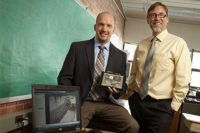Hector Rodriguez: "Hope" Is Not a Plan

Hector Rodriguez, Ed.D.
Chief of Police, Santa Ana Unified School District Police Department
Chief Hector Rodriguez believes so much in the Santa Ana Unified School District (SAUSD) and the safety of the children who attend SAUSD schools that he sends his own children to school there.
“We are protecting very valuable assets – children,” he says, “so one of the things that I did was enroll my sons in the school district. This a very challenged district with its share of community issues and under-resourced agencies, yet I brought my two boys here to make the point that we trust our officers with the most valuable things that parents have.”
The Santa Ana Unified School District Police Department is a school district in Orange County, California, that serves the city of Santa Ana. Although its geographic size is only 26 square miles, it is the sixth largest school district in the State of California with approximately 58,000 students.
Chief Rodriguez has worked to not just teach his 26 officers (eight of whom are school resource officers) about safety; he has taught prevention and intervention strategies as a means of addressing school security problems.
He understands a police agency’s constantly evolving role in the community. He has more than 26 years of law enforcement experience, 23 of which have been in the area of school policing. Prior to his selection as Chief, he was a member of the Los AngelesSchool Police Department (LASPD) for more than 22 years, with his most recent assignment as Deputy Chief of Field Operations; a command of approximately two-thirds of the 360 sworn officers.
Other assignments included overseeing the LASPD’s Communication Center, as well as canine operations, firearms training, motors and the technology unit. In addition, Chief Rodriguez also has significant operational experience at the executive level of police administration including internal investigations, audits and strategic planning. He also served as a full-time, as well as a line reserve police officer with the Los Angeles Police Department (LAPD). He holds master’s and doctorate degrees in Education from the University of Southern California.
“We are working at creating the safest possible campuses,” he says. “We are not focusing solely on enforcement, but also on prevention and intervention. We realize that we help shape our kids’ views about police officers and government in general, based on our contacts with them. We strive to engineer trust and build collaboration. We are very well prepared to respond to active shooter events, but more importantly, we want to ensure as much as possible that we get to the child before he or she gets to that point of wanting to cause harm.”
“Our schools are not violent, but we recognize that some of our schools are located in socio-economically challenged areas with a higher rate of crime issues. Occasionally, some of these issues will spill on to our campuses,” he adds. “So our officers need to know what’s going on in the neighborhoods.”
One area of attention in the media, with regards to school security, is arming school resource officers. SAUSD’s school resource officers are armed. “It’s an unfortunate necessity. They have to protect the students and themselves. There’s no question. You cannot have a police officer on a campus that is not armed. We hope that they don’t have to use their weapon, but hope is not a plan. We are not arming teachers, though; teachers are there to teach and protect our children, but they don’t have the same mindset or level of training that we do with regards to the use of a firearm as a defensive tool.”
Armed or not armed, Chief Rodriguez says, is not the focus. Instead, it’s training his staff to be completely engaged on campus to build trust. “The more trust that students have in our officers, the more information they will receive about gangs, theft and at-risk students who can cause problems.”
He aligns his outreach efforts with the goal of closing the achievement gap within the district, helping to push higher graduation rates and getting more kids to attend college. “If you approach the problem from that perspective, you are solving a lot of community crime issues,” he says. He does so by sending his staff to training beyond tactical mandates and giving them classes on understanding the development of the teenage brain. “A teenager does not have fully developed rational thought processes,” he adds. “Our officers need to understand this in order to better engage young adults who are still developing as human beings.”
Another type of training is how to address runaways from a counseling perspective and to give parents resources that can impact the quality of life on campus. He stresses: “We have a daily opportunity to impact a young person’s life. I talk about that every day. If we do our job right, we will have an impact on the community crime rate because our kids will graduate.”
All of his officers will receive EMT training this year, further perpetuating the idea that they are there to help and support students and not necessarily be just an enforcer. While he has support from parents and the school board, he does admit that there’s a challenge to measure prevention. “If there’s no crime, people assume that you don’t need the resources that you are asking for. But that’s when you really need them because you are making a difference.”
Security Scorecard
- Annual Operating Revenue: $505 Million
- Security Budget: $7.2 Million
Critical Issues
- Increase in Crimes
- Providing Relevant Threat Assessment Training to Officers and Changing the Mindset from Reactive to Preventative/Predictive
- Civil Activism/Demonstrations
Security Mission
- Active Shooter
- Asset Protection/Theft
- Contract Management (Guards, Technology Integrators, Contract Employees)
- Enterprise Resilience
- Investigations
- Security Technology and Integration
- Terrorism
- Workplace Violence
Looking for a reprint of this article?
From high-res PDFs to custom plaques, order your copy today!






